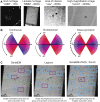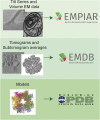Recent advances in infectious disease research using cryo-electron tomography
- PMID: 38288336
- PMCID: PMC10822977
- DOI: 10.3389/fmolb.2023.1296941
Recent advances in infectious disease research using cryo-electron tomography
Abstract
With the increasing spread of infectious diseases worldwide, there is an urgent need for novel strategies to combat them. Cryogenic sample electron microscopy (cryo-EM) techniques, particularly electron tomography (cryo-ET), have revolutionized the field of infectious disease research by enabling multiscale observation of biological structures in a near-native state. This review highlights the recent advances in infectious disease research using cryo-ET and discusses the potential of this structural biology technique to help discover mechanisms of infection in native environments and guiding in the right direction for future drug discovery.
Keywords: bacteria; cryo-EM; cryo-ET; host-pathogen interaction; infectious diseases; pathogen; viruses.
Copyright © 2024 Asarnow, Becker, Bobe, Dubbledam, Johnston, Kopylov, Lavoie, Li, Mattingly, Mendez, Paraan, Turner, Upadhye, Walsh, Gupta and Eng.
Conflict of interest statement
The authors declare that the research was conducted in the absence of any commercial or financial relationships that could be construed as a potential conflict of interest.
Figures







References
Publication types
Grants and funding
LinkOut - more resources
Full Text Sources

